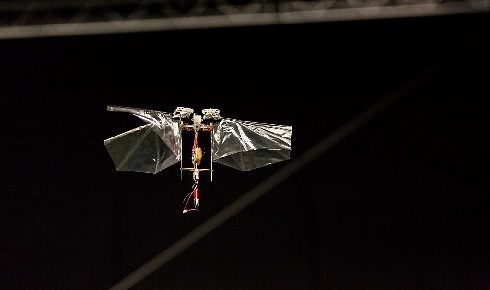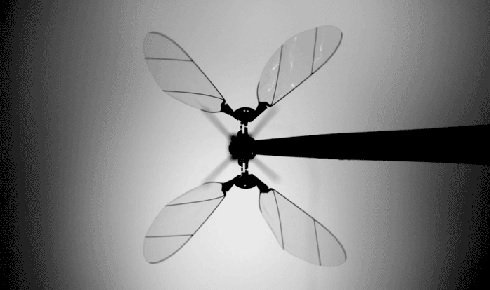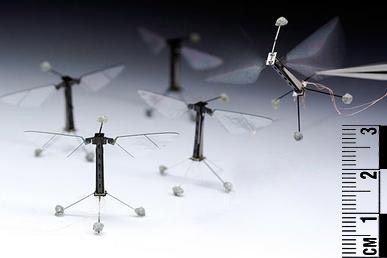No, ‘robobees’ are not the answer to pollinator decline

Despite the best intentions of engineers and technologists, the trillions of micro aerial vehicles required to do the job of bees and other pollinators would be an ecological disaster
December 4th 2020
Food security and the health of ecosystems depend on plant–insect interactions in countless ways. Pollination is particularly important for human food production and for terrestrial ecosystem survival. Recently reported rapid and immense declines in insect numbers due to climate change, the use of pesticides and herbicides, the introduction of agricultural monocultures and the destruction of insect native habitat are all potential contributors to a loss of insect pollinators[1].
This has grabbed media attention, with warnings about the ‘insect apocalypse’[2] and ‘insect Armageddon’[3], and although these reports were tempered by some within the ecological community[4], the notion that our insects are suffering under many combined threats is not controversial.
Robobee hype
For several years some researchers have been working towards a future where natural insect pollinators might be replaced or supplemented with free-flying robotic bees in the form of micro unmanned aerial vehicles. This has been surprising to ecologists and biologists, and subsequently met with a degree of incredulity and ridicule from some in those fields. But the evidence that some engineers feel this to be a viable, valuable and desirable replacement for insect pollination is widespread and public – and has been sporadically but persistently sensationalised in the mainstream popular science media[5-11].
 Researchers have been working towards a future where natural insect pollinators might be replaced with robobees
Researchers have been working towards a future where natural insect pollinators might be replaced with robobees“Thousands of robotic insects will take to the skies in pursuit of a shared goal,” claimed Scientific American in 2013[12]. “Robotic bees could help pollinate crops as real bees decline,” suggested New Scientist magazine in a provocative 2017 headline[13]. And, in The Guardian in 2018, “…researchers in the university’s newly opened Robohouse… believe they will be able to create swarms of bee-like drones to pollinate plants when the real-life insects have died away[14]”.
Environmental catastrophe
Robobees are ecologically problematic from a number of interrelated perspectives. The first issue is one of scale. A back-of-the-envelope estimate using available statistics suggests the world had approximately 16 trillion managed honeybees in 2016, and that was insufficient to meet the global need for agricultural pollination. This calculation didn’t consider the trillions of wild honeybees, nor the tens of thousands of other bee species, countless species of flies, butterflies, moths, beetles, wasps and other insects that are also important crop pollinators.
In short, if insects do die off in large numbers, we’d need an uncomfortable number of robobees to replicate their pollination benefits. Robobees cost money to manufacture too, unlike wild insects, so they would perhaps serve only wealthy growers. The world’s smallholder and subsistence farmers living in developing nations, who operate around 75% of the world’s farms with a fraction of the finances of their industrial counterparts[15], are unlikely to be able to afford robobee swarms.
The manufacture of robobees is also environmentally damaging. Materials are needed to create structural elements, plastics, membranes, wires and foils, resins and carbon fibre. Fine metalwork is used for electronics, and chemicals for high-performance battery cells and to generate solar power.
If robobees working open fields and orchard crops stray or become damaged, unretrieved devices will litter and pollute the environment. They may leach battery contents and other chemicals into waterways, the oceans and forests. They will leave microplastics as they disintegrate. This is especially concerning since proposed designs are consumable and damage-prone, but not biodegradable or recyclable.
Robobees would be harmful if accidentally consumed by the countless birds, reptiles and amphibians that live on a steady diet of the flying insects they mimic. (If ingested by crop-duster aircraft engines, robobees are even potentially hazardous to human pilots – hard materials are likely to damage engine components, possibly causing catastrophic failure.)
 Robobees, developed by a research team at Harvard University
Robobees, developed by a research team at Harvard UniversityRobobees would displace wild and managed insect pollinators, many of which have highly specialised interactions with endemic flowering plants, further driving their decline and increasing human dependence on alternative pollination practices for food production.
Robobees would not pollinate wildflowers – from the perspective of a grower that would be a waste of resources, and from the perspective of an engineer that would require them to be exceedingly diverse and subtle in their flower-handling capabilities.
Technology for good
Instead of designing robobees, creating environments friendly to biological bees and exploring the use of other insect species for pollination are more ecologically sound approaches to tackling world food production problems. However, this needn’t mean that technology must be left aside altogether. In fact, current digital technology has great potential to facilitate crop and wildflower pollination, and to help us support insects and the ecosystems that depend on them – a goal of my own research group.
For instance, machine learning and computer vision techniques can be applied to social network site image analysis to conduct continental-scale bee surveys[16]. Related techniques applied to video data can capture insect movements on strawberries and wildflowers, and teach us how insects make foraging decisions[17].
We use simulations, including the same kind of ‘agent-based models’ used in epidemiology, to simulate individual insect movement in greenhouses[18], and to explore how different insect species perceive crop and wildflower environments[19]. Researchers are connecting managed beehives to internet-of-things devices to provide real-time data on honeybee colony health, something that is also gaining traction in industry[20].
The use of app-controlled pheromone lures to attract and orchestrate the movement of hoverfly pollinators is also being trialed[21]. In short, pollination practices stand to benefit substantially from technological enhancement. However, adding trillions of expensive, non-biodegradable, toxic, flapping microrobots to ecosystems and farms is not, in my opinion, a way forward.
Alan Dorin is associate professor at the Faculty of Information Technology, Monash University, Australia. He researches the ways in which technology assists discovery in the ecological sciences and in human creativity.
1) Sánchez-Bayo, F. & Wyckhuys, K. A. G. Worldwide decline of the entomofauna: A review of its drivers. Bio. Cons. 232(1), 8–27 (2019).
2) ‘Insect apocalypse poses risk to all life on Earth conservationists warn’. The Guardian, Nov 2019. Accessed 18 Sep 2020.
3) ‘Insect Armageddon: Europe reacts to alarming insect decline.’ ABC.net, Oct 2019. Accessed 18 Sept 2020.
4) Saunders, M. E. et al. Moving on from the insect apocalypse narrative: engaging with evidence-based insect conservation. BioScience 70(1), 80–89 (2019).
5) Berenbaum, M. Bot-flying. Am. Entomol. 65(2), 76–78 (2019).
6) Chechetka, S. A, et al. Materially engineered artificial pollinators. Chem. 2(2), 224–239 (2017).
7) O’Brien, M & Kellan, A. RoboBees: design poses intriguing engineering, computer science challenges. Science Nation, National Science Foundation: Prototype Today (2012).
8) ‘Watch this $100 drone try to do a bumblebee’s job’. MIT Tech. Rev. Feb 2017.
9) ‘Pollination drones seen as assistants for ailing bees’. Robotics Business Review, March 2018.
10) Williams, C. Summon the bee bots: Can flying robots save our crops? New Scientist 220(2943), 42–45 (2013).
11) Wood, R. et al. Flight of the robobees. Sci. Am. 308(3), 60–65 (2013).
12) ‘The robobee project is building flying robots the size of insects’. Sci. Am. March 2013.
13) ‘Robotic bee could help pollinate crops as real bees decline.’ New Scientist, Feb 2017.
14) ‘Robotic bees could pollinate plants in case of insect apocalypse’. The Guardian, Oct 2018.
15) Lowder, S. K, et al. The number, size, and distribution of farms, smallholder farms, and family farms worldwide. World Dev. 87(1), 16–29 (2016).
16) ElQadi, M. M. et al. Mapping species distributions with social media geo-tagged images: Case studies of bees and flowering plants in Australia. Ecol. Inform. 39(1), 23–31 (2017).
17) Ratnayake, M. N. et al. Tracking individual honeybees among wildflower clusters with computer vision-facilitated pollinator monitoring. BioRxiv (2020).
18) Dorin, A. et al. Simulation-governed design and tuning of greenhouses for successful bee pollination. Artificial Life, 171–178 (MIT Press, 2018).
19) Bukovac, Z. et al. Assessing the ecological significance of bee visual detection and colour discrimination on the evolution of flower colours. Evol. Ecol. 31(2), 153–172 (2017).
20) https://hivemind.nz
21) www.flypollination.com


